Content
The properties of sphagnum moss are appreciated in folk medicine. The plant helps to cope with many diseases and improves skin condition, but you must first study the rules for its use.
What does sphagnum moss look like and where does it grow?
Sphagnum, or peat moss (Sphagnum), is a plant that lives in upland and transitional bogs. It is represented by spore perennials, which annually grow the upper part, while the lower one dies off. The plant has special dead water-storing cells on the leaves and stem. They are hollow and transparent, with small holes. The main part of the plant is represented by green photosynthetic cells; peat moss also has a leg and a spore capsule.
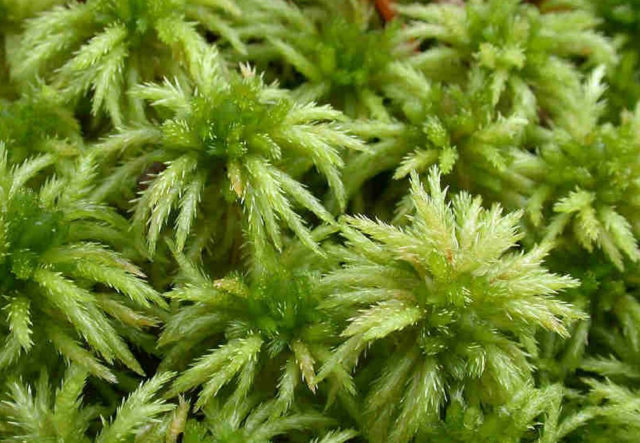
Sphagnum is widespread in the temperate climate of the Northern Hemisphere, found in all regions of Russia, and can also be seen in South America. Artificially for industrial purposes, the culture is bred in New Zealand, Australia, Canada and the Scandinavian countries. Moss settles in wet areas, takes an active part in swamping forests and overgrowing lakes. Usually occurs in large colonies and forms wide dense carpets in swamps.
Sphagnum composition
Photos of sphagnum moss and its use are of interest due to the rich composition that is responsible for medical value. In particular, the plant contains:
- sugars and pectins;
- phenolic acids;
- flavonoids;
- iron and calcium;
- cellulose;
- magnesium and silver;
- coumarins;
- organic acids;
- resins and aldehydes.
Some components in the composition of the marsh plant are toxic, so it is necessary to use moss inside for ailments with caution and in small doses.
The healing properties of sphagnum moss
Traditional medicine uses sphagnum to treat chronic and acute diseases. When used correctly, marsh moss:
- suppresses bacterial processes and helps to cope with salmonella, cocci, E. coli and even cholera;
- promotes the elimination of fungi;
- disinfects irritations and injuries on the skin;
- stops bleeding;
- has an analgesic effect;
- relieves swelling and inflammation in rheumatism, arthritis and gout;
- promotes expectoration for colds and bronchitis;
- improves the condition with colitis and enterocolitis;
- eliminates bacterial processes in case of angina and dental ailments.
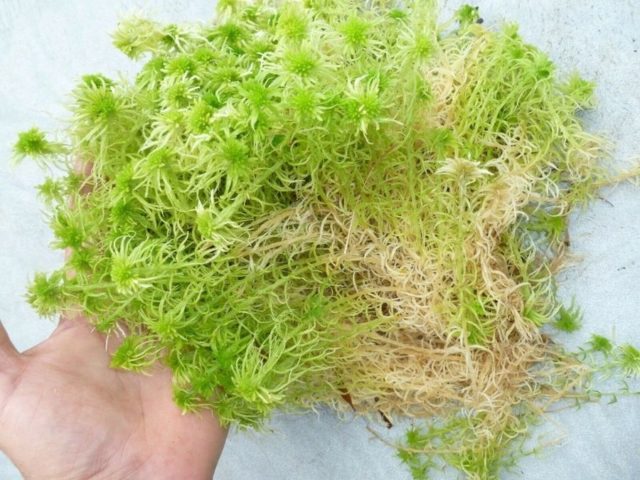
The use of sphagnum in medicine
Traditional medicine applies the medicinal properties of bog moss by internal and external methods. First of all, sphagnum is used for applications and compresses, but there are also recipes for useful decoctions and tinctures based on it.
With fungal diseases
The disinfecting properties of the marsh plant are beneficial for fungus. Apply moss as follows:
- pour 100 g of raw materials with a glass of strong medical alcohol;
- leave for two hours;
- remove the moss and wring it out gently;
- applied to the affected areas.
From above, the compress is fixed with a bandage. It takes 15 minutes to keep sphagnum on the skin, the procedure is repeated several times a day until the condition improves.
With eczema
The anti-inflammatory properties of white moss are used for eczema and dermatitis. For internal use, prepare the following infusion:
- 10 g of sphagnum is mixed with an equal amount of dry verbena, sand sedge, clover and stockrose petals;
- add 10 g of marsh creeper, galangal root, river gravilata and medicinal primrose;
- measure 10 g of the healing mixture and pour 500 ml of hot water;
- leave under the lid to infuse for two hours.
The filtered product is drunk in 200 ml shortly before meals three times a day. Also, sterile gauze dressings are moistened in the infusion and applied to the affected skin for 20-30 minutes.
With a cold
Sphagnum helps to relieve unpleasant flu and SARS symptoms and makes breathing easier with a runny nose. Traditional medicine recommends this remedy:
- two large spoons of moss are poured with a glass of hot water;
- cover the container with a lid and leave for an hour;
- filter after time.
With a ready-made infusion, you need to rinse your nose several times a day. Moss will quickly relieve congestion.
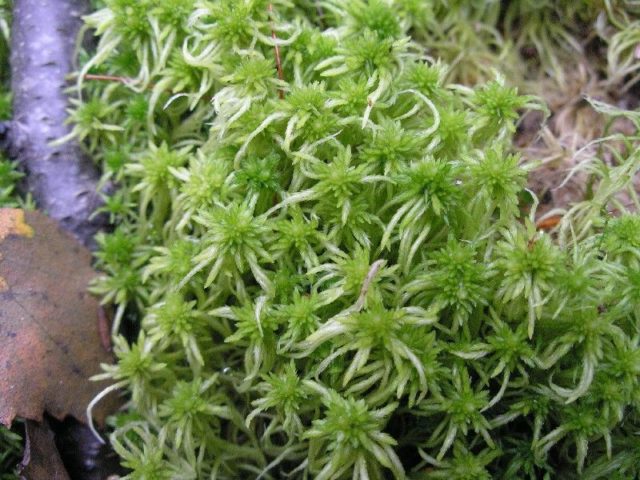
With bronchitis
The expectorant properties of sphagnum are used for bronchitis and colds. Prepare such a tool:
- pour 10 g of moss into a thermos and pour 250 ml of boiling water;
- cover with a lid and leave for three hours;
- filter from sediment.
It is necessary to take an infusion of 20 ml three times a day.
With intestinal colitis
The antiseptic properties of sphagnum help to cope with intestinal inflammation. For colitis, it is recommended to grind the dried moss to a homogeneous powder and consume 5 g on an empty stomach three times a day. The product can be taken with a little water.
With open wounds
Swamp sphagnum powder is used for fresh cuts, open wounds, abrasions and burns. White moss is thoroughly crushed to a state of dust, and then a pinch is measured and sprinkled directly on the affected area.
The powder is left on the wound for ten minutes, after which it is washed with clean water. Sphagnum disinfects tissues and protects against inflammation.
With angina
Swamp moss helps to quickly relieve the inflammatory process in the throat with sore throat, relieves pain and facilitates the swallowing process. Traditional medicine recommends this remedy:
- a small spoonful of sphagnum is poured into a dry thermos;
- pour 150 ml of boiling water;
- tighten the lid tightly and leave to infuse for half an hour.
The finished product is filtered and used for rinsing up to six times a day. Continue therapy for at least five days.
For skin rashes and rheumatism
For joint ailments and dermatitis, baths with the addition of marsh moss help well. The medicinal broth is prepared according to this recipe:
- 500 g of sphagnum is poured into 10 liters of water in a large saucepan or enamel bucket;
- heated on the stove after boiling for five minutes;
- pour the broth into a bathing container.
The water temperature should be no more than 37 ° С, and you need to take a healing bath for half an hour. With exacerbations of rheumatism and severe skin inflammation, the procedure is repeated every evening until the condition improves.
For skin ulcers
Swamp moss promotes the healing of skin lesions and fights purulent processes. For inflamed ulcers, it is necessary:
- grind dried sphagnum into powder;
- mix in equal proportions with petroleum jelly;
- heat up with steam so that the product acquires a semi-liquid consistency.
The resulting ointment is applied to the damaged areas several times a day and covered with a bandage.
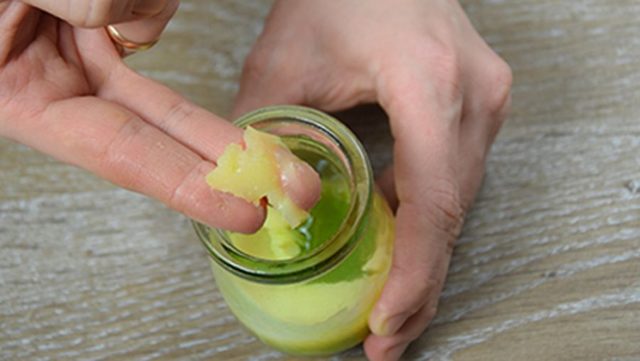
With bedsores
The valuable properties of the marsh plant can be used in the care of bedridden patients. Against the background of prolonged immobility, people often develop bedsores. Sphagnum moss will be useful in their prevention and treatment. It is used like this:
- they sew for the patient a rug of the right size from natural linen fabric;
- divide the product into strips 5 cm wide;
- stuff the rug from the inside with dry marsh moss.
When caring for a bedridden patient, it is necessary to perform therapeutic massage and use special preparations. But using an antiseptic mat will also help with pressure sores.
The use of sphagnum moss in floriculture
The benefits of sphagnum, or marsh moss, are manifested not only in medicine, but also in floriculture. The plant is a good moisturizer, effectively absorbing and releasing water, it can disinfect the soil and improve its quality characteristics. Swamp moss is used to prevent mold and mildew in plastic and ceramic pots.
In floriculture, sphagnum is used for several purposes:
- For growing demanding flower crops such as orchids. Marsh moss is mixed with coconut fiber and pine bark to obtain a breathable, healthy and plant-safe soil. Flowers in such a mixture do not dry out, but they do not suffer from waterlogging either.
- For rooting cuttings. Dracaena and pelargonium sprouts are planted in moist sphagnum. Moss retains water well and nourishes the cuttings, and also disinfects the slices and prevents them from rotting. The sprouts give roots in a few days, after which they can be transplanted into ordinary soil.
- For regulation of air humidity. In summer and winter, sphagnum helps maintain a healthy microclimate for indoor plants. The moss should be placed on pallets of pots or placed next to the flowers and moistened regularly. The moisture will evaporate and prevent the leaves from drying out.
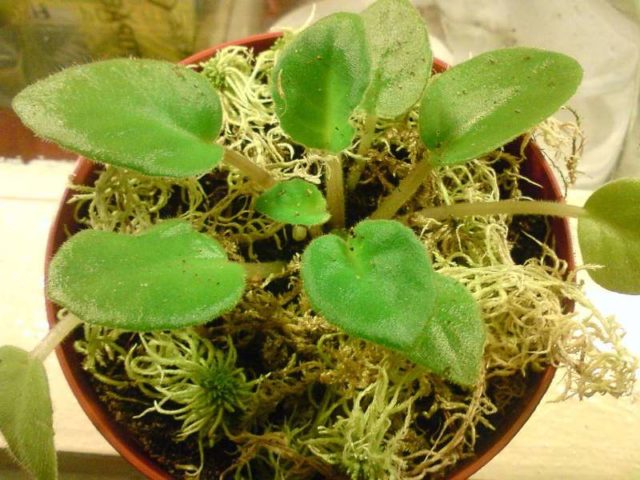
Contraindications
With the numerous beneficial properties of sphagnum moss, it is not allowed to use it for everyone. It is necessary to refuse to use the plant:
- with acute digestive disorders;
- with exacerbation of pancreatitis and stomach ulcers;
- with chronic hypertension;
- with serious cardiovascular ailments;
- with nephrosonephritis;
- if you have an individual allergy.
Sphagnum-based products should not be used by pregnant women and nursing mothers. Also, swamp moss inside is not offered to children under three years old, the medicinal plant can harm the baby's digestive system.
When and where is it better to collect sphagnum moss
Harvesting of sphagnum moss for medicinal purposes is carried out most often from late spring to autumn, but in fact any time of the year is suitable. It is necessary to collect the plant in an ecologically clean area, located away from roads and industrial facilities. It is better to take the sphagnum that is located near the trees in the swamp, it is less watery.
An interesting feature of the plant is that it does not lose its beneficial properties even in frost. Sometimes harvesting is carried out, including in winter, digging up moss from under the snow.
How to collect sphagnum moss
There are two ways to collect sphagnum moss in the forest:
- Completely remove the plant from the ground along with the root part. In this case, the workpiece will be more abundant, and the moss will be longer. But it will have to be carefully shaken off from specks, needles and brown leaves.
- Cut only the upper part with sharp scissors. You will be able to collect less moss, or it will take more time to harvest, but the raw materials will be cleaner.
In order for sphagnum growing wild in a swamp to recover safely, it is necessary to cut or pull it out not over the entire area, but in rows of 30 cm wide. Between them you need to leave the same space of untouched moss.
Immediately after collection, sphagnum is cleaned of debris and brown spots are removed, wrung out and stored in a plastic bag in a wet state. You can keep swamp moss in the refrigerator or even outside in the cold.
Another method suggests preparing sphagnum by spreading it out on a flat surface or hanging it from the ceiling. The moss will turn white as it dries. Then it will need to be distributed in paper bags and put away in a dark place. In the dry state, the plant will retain its valuable properties and elasticity, and when wet, it will retain moisture just as well.

Conclusion
The properties of sphagnum moss are highly appreciated by traditional medicine. The bog plant is an excellent natural antiseptic, often used to treat wounds and ulcers, and also fights internal inflammation and infections.

